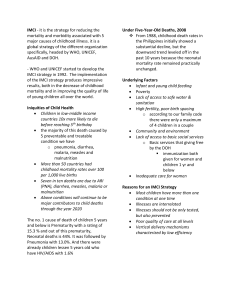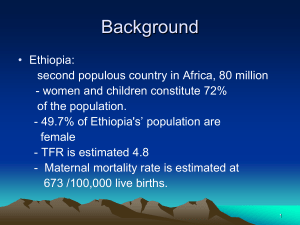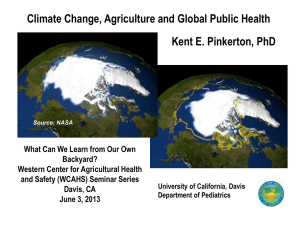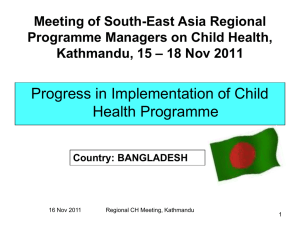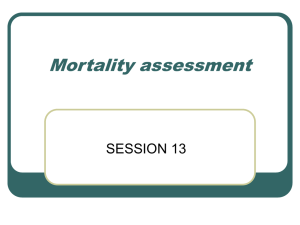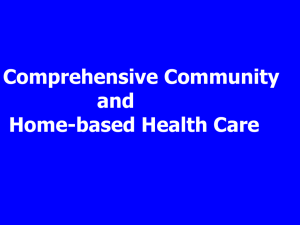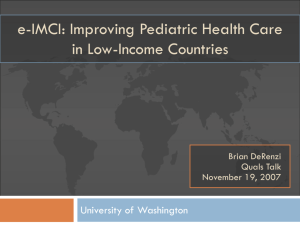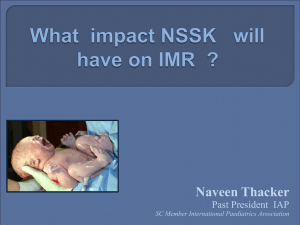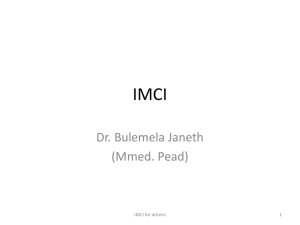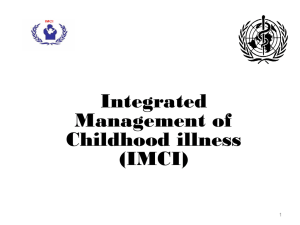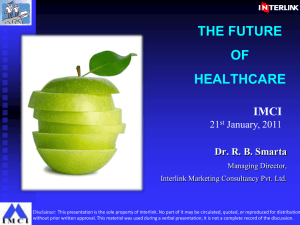View Presentation
advertisement
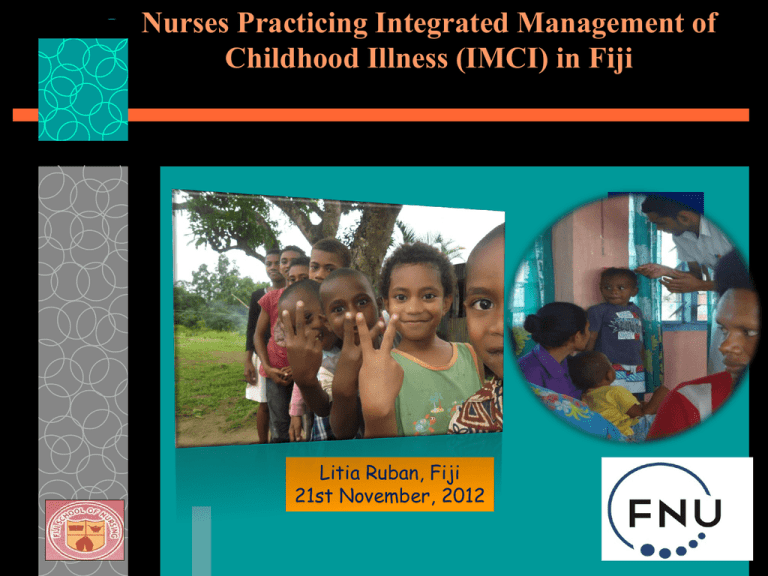
Nurses Practicing Integrated Management of Childhood Illness (IMCI) in Fiji Litia Ruban, Fiji 21st November, 2012 Presentation Outline 1. 2. 3. 4. Objectives of IMCI Introduction Implementation of IMCI Component Way Forward Integrated Management of Childhood Illness (IMCI) Objectives To reduce significantly global mortality and morbidity with the major causes of disease in children through an integrated approach. To contribute to healthy growth and development of children Introduction As according to UNICEF Child Mortality Report 2011, the global under-five mortality rate since 1990 has dropped 35 percent—from 88 deaths per 1,000 live births in 1990 to 57 in 2010. The rate of decline in under-five mortality has accelerated— from 1.9 percent a year over 1990–2000 to 2.5 percent a year over 2000–2010—but remains insufficient to reach MDG 4, particularly in Sub- Saharan Africa, Oceania, Caucasus and Central Asia, and Southern Asia. Only three years remain to achieve Millennium Development Goal 4 (MDG 4), which calls for reducing the under-five mortality rate by two thirds between 1990 and 2015 • Introduction Where is Fiji NOW on the Road “To reduce Child Mortality and Morbidity by 2/3 in the Year 2015”? Fiji’s Level and Trends of Child Mortality for the Last 20 years Under five mortality rate(deaths per 1000 live births) Millennium Development Goal target for 2015 Average rate of reduction (percent) Number of under five deaths (thousands) Infant mortality rate (deaths per 1000 live births) Number of infants deaths (thousands) Neonatal mortality rate (deaths per 1000 live births) Number of neonatal deaths (thousands) 1990 2010 2015 1990 -2010 1990 2010 1990 2010 1990 2010 1990 2010 1990 2010 30 17 10 2.8 1 0 25 15 0 0 12 8 0 0 Source: Levels and Trends of Child Mortality, Report 2011, Estimates Developed by the UN Inter Agency Group for Child Mortality Estimation (IGME) Introduction Comparing Fiji’s levels and trends of CMR to other Pacific Islands Country Under five mortality rate(deaths per 1000 live births) Millennium Development Goal target for 2015 Average rate of reduction (percent) Number of under five deaths (thousands) Infant mortality rate (deaths per 1000 live births) Number of infants deaths (thousands) Neonatal mortality rate (deaths per 1000 live births) Number of neonatal deaths (thousands) 1990 2010 2015 1990 -2010 1990 2010 1990 2010 1990 2010 1990 2010 1990 2010 Fiji Australia Cook Islands Marshall Islands 30 9 20 51 17 5 9 26 10 3 7 17 2.8 2.9 4 3.4 1 2 0 0 0 1 0 0 25 8 17 40 15 4 8 22 0 2 0 0 0 1 0 0 12 5 9 19 8 3 5 12 0 1 0 0 0 1 0 0 Papua New Guinea 90 61 30 1.9 12 12 65 47 9 10 30 23 4 5 Samoa Solomon Tonga Tuvalu Vanuatu New Zealand 27 45 25 57 39 11 20 27 16 33 14 6 9 15 8 19 13 4 1.5 2.6 2.2 2.7 5.1 3.0 0 1 0 0 0 1 0 0 0 0 0 0 23 36 21 44 31 9 17 23 13 27 12 5 0 0 0 0 0 1 0 0 0 0 0 0 10 18 11 22 16 4 8 12 8 14 7 3 0 0 0 0 0 0 0 0 0 0 0 0 • Source: Levels and Trends of Child Mortality, Report 2011, Estimates Developed by the UN Inter Agency Group for Child Mortality Estimation Introduction In terms of Child Morbidity . What has Fiji done on the Road “To reduce Child Mortality and Morbidity by 2/3 in the Year 2015”? WHO and UNICEF launched IMCI strategy in the mid – 1990s to reduce deaths from diarrhea, pneumonia, malaria, measles and malnutrition in children younger than 5 years The Ministry of Health, Fiji works in collaboration with WHO/UNICEF to strengthen the implementation of Integrated Management of Childhood Illness (IMCI). Fiji Implementing IMCI Component 1. Improving case management skills of health workers - standard guidelines – upgrading case management & counselling skills -training (pre-service and in-service) - follow-up after training 2. Improving the health system to deliver IMCI - essential drug supply and management - organization of work in health facilities - management and supervision 3. Improving family and community practices Implementing IMCI Components Improving case management skills of health workers (mainly nurses) IMCI Training in Fiji National and outreach training done are mainly for the registered nurses while few were doctors and sisters. More than 1000 nurses had been trained from then till to date. 2003, the IMCI component was in cooperated into the nursing curriculum during the curriculum review First pre service class to take this up was in 2004 and they graduated in 2007 April,2009 ICAAT training was conducted to both pre services/post services at Fiji School of Nursing. Total trained per Year in the Preservice Level…… GRAD/YEARS FIJI OTHER PACIFIC TOTAL ISLANDS 2007 171 3 174 2009 84 10 94 2010 97 5 102 2011 109 2 111 2012 110 5 115 2013 147 3 150 TOTAL 718 28 746 Total trained per Year in the Post Service Level…… PROGRAM 2009 Fiji Adv.Dip.Npract. 10 PGDip.Midwifery 2010 OPac Fiji OPac Fiji OPac Fiji 10 5 60 45 50 T O T OPac 15 15 Bach.PHNur TOTAL 2012 10 PGCert.Mental Health Nur Post Basic PH 2011 25 70 70 19 5 74 5 2 2 IMCI Components Improving the health system to deliver IMCI IMCI SET UP IN CLINICAL AREAS ------------ IMCI Components Improving practices family and community Limitations Inadequate Lack resources of Management, Coordination andSupervisory Systems Lack of analysis on child health data. From now 2015 PHC Strengthening & revitalization Child Health- IMCI CHILD SURVIVAL Maternal and Neonatal HealthCare Strengthening Health Information System Vinaka Vakalevu
